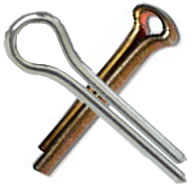
Cotter pins are fasteners consisting of a piece of metal. Also known as split pins, they are designed for use in holes. You can insert a cotter pin into a hole to secure a component. And you can typically remove cotter pins by pulling them out of the hole. While all cotter pins function as metal fasteners, though, they are available in different types.
Extended Prong
One of the most common types of cotter pins is extended prong. As shown in the adjacent photo, extended prong cotter pins feature two long and narrow parallel prongs. One of the prongs is slightly longer than the other prong.
To use an extended prong cotter pin, simply insert it into a hole. You can then bend the ends of the prongs around the back of the component. Bending the ends of the prongs will secure the cotter pin and, thus, the component with which it’s used.
R-Clip
R-clip cotter pins are made of metal as well, but they are shaped differently. They don’t feature the same U-shaped design as extended prong cotter pins. Rather, R-clip cotter pins feature an R-shaped design.
R-shaped cotter pins are used around cylindrical-shaped components, such as tooling balls. They feature two prongs — just like extended prong cotter pins. But only one of the prongs is straight. The other prong on an R-clip cotter pin is curved.
To use an R-clip cotter pin, you’ll need to insert the straight prong into a hole. The curved prong should then wrap around the side of the cylindrical-shaped component
Hammer Lock
Hammer lock cotter pins are a type of locking fastener that, as the name suggests, requires a hammer to install. They look like extended prong cotter pins. The only difference is that hammer lock cotter pins are curved on the end. The end of the long prong curved inward towards the opposite, shorter prong.
You can use a hammer lock cotter pin by inserting it into a hole and then striking it with a hammer. As you strike the head with a hammer, the ends of the prongs will close together.
Extended prong, R-clip and hammer lock are some of the most common cotter pins. They all consist of a single piece of bent metal with two prongs. Each type, though, works in a different way. Extended prong cotter pins are bent around the back of components manually. R-clip cotter pins feature a curved prong that wraps around the side of components. Hammer lock cotter pins require a hammer to install, which will close the ends of the prongs together.



